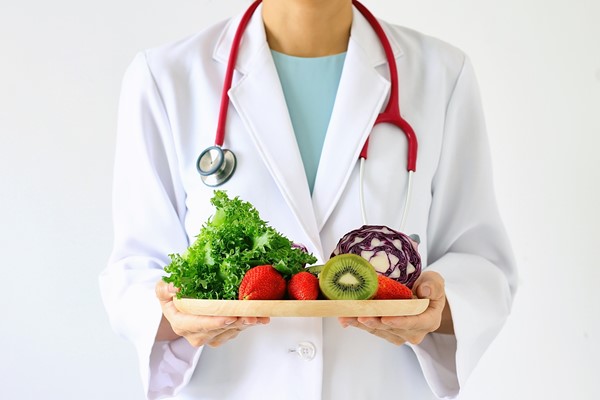|
Patient education handout (download) |
Why is it important for me to eat well when I have a wound?
One of the aspects of wound healing that is easily missed has to do with what you eat, that is your “nutrition.” The term “nutrition” can be as simple as “the process of obtaining food for health and growth.”[1] However, the specific diet that each person needs is unique. There is a lot of information around nutrition, but how do you know what is right for you?
Your body is like a machine that requires the right fuel to keep you moving. When you have a wound, your body has to work harder than normal to repair and maintain your well-being. The right fuel, in this case, is a well-balanced diet, including more calories, proteins, vitamins and minerals, and of course, lots of water.

What should I eat?
Eating a healthy and balanced diet is easier said than done, you may have other medical conditions or complications that conflict with repairing your wound. It is important to follow the recommendations provided by your healthcare professional, especially if you have other conditions that affect what you eat, such as diabetes, high blood pressure, renal disease, allergies, etc. For more details, see topic "Nutrition for wound healing - What if I have other health conditions?"
Macronutrients and Micronutrients
To create a meal plan that fits your needs, it is helpful to have a basic understanding of “macronutrients” and “micronutrients” and their role in our bodies. The main difference is that macronutrients provide energy to the body while micronutrients do not. Table 1 below summarizes roles and sources of each nutrient.
Carbohydrates, fats and proteins are macronutrients
Vitamins and minerals are micronutrients
Table 1. Food nutrients, their roles, and sources [2][3]
| Food Nutrients | Why is it important? | What should I eat? |
| Macronutrients |
|
|
Carbohydrates
| The primary source of energy in most diets and are abundant in foods. Carbohydrates are broken down into simple sugars such as glucose and used by all cells in your body, including your central nervous system (your brain)!
| - Green vegetables
- Whole grains and foods made from whole grains
- Starchy vegetables like potatoes and corn
- Beans, lentils, and peas
- Fruit
|
| Proteins | Building blocks of your body. Proteins are involved in tissue structure (part of organ tissues, muscle, hair, skin, nails, bones, tendons, ligaments, and blood plasma). These building blocks are vital for the repair of wounds as they will create the new, healthy tissue that replaces the damaged ones.
| Lean meatSeafoodWhite meat poultryEggsMilk, cheese and yogurtBeansSoy |
Fats
| Concentrated source of energy, containing more than twice the calories per gram as carbohydrates. They act as an energy reserve and insulate your vital organs. These should be part of a healthy diet but eaten less frequently and make up a smaller percentage of your diet.
| - Avocado
- Nuts
- Oils such as olive oil, and coconut oil
- Fatty fish such as salmon and trout
|
Micronutrients
|
|
|
Vitamins (e.g. vitamin A, C, K, etc.)
| Multiple functions across all organ systems, vital to good health.
| Many varied sources depending on the vitamin (see handout "Vitamins and Minerals"). Talk to your health care provider about a specific vitamin and their source in foods. |
Minerals (e.g. copper, iron, zinc, calcium)
| Help your cells renew and stay healthy. Should be in balance
| - Brazil nuts, cashew nuts
- Cheese, eggs, milk
- Chicken, meat, liver
- Seeds
- See handout "Vitamins and Minerals"
|
| Water |
|
|
| Water | 70% of the human body is water, but most people do not drink enough water. Water is essential for all the body’s functions. It supports cellular function and eliminates the body’s waste. If you have a wound with large amounts of drainage, your body needs more water | - Choose water instead of sugar-sweetened beverages such as soda, sweetened juices.
- Choose water when eating out. Generally, you will save money and reduce calories.
- For taste, try adding a wedge or lime or lemon to your water. This can help you drink more water
|
Food Groups
Now that we know the basics of nutrients, let’s dive into the different food groups. Most people can name fruits and vegetables as food groups, but other groups are just as important. Once you have an understanding of each unique group, it can be much easier to create meals that include all the nutrients needed by your body. For pictures and sample portions of food groups see handouts "What's MyPlate All About?" and "MyPlate, MyWins, Make it Yours". Table 2 below summarizes the roles and sources of each food group.

Table 2. Food groups, their roles, and sources [4]
| Food groups | Why is it important? | What should I eat? |
Vegetables
| Vegetables are important sources of many nutrients, including dietary fiber, vitamins, and carbohydrates
| Include a variety of vegetables from all of the five vegetable subgroups: - Dark green (vitamin K)
- Red and orange (vitamin A)
- Legumes, such as beans and peas (fiber)
- Starchy (potassium)
- Other (combination of nutrients in different amounts)
|
Fruits | Among the many nutrients, fruits provide potassium, vitamin C, and dietary fiber | They can be whole fruits or 100% fruit juice. Whole fruits include fresh, canned, frozen, and dried. Avoid juice and cans with added sugar as you can lose fiber and gain excess calories |
Grains | - Whole grains contain the entire grain kernel and are a source of nutrients, such as dietary fiber, iron, zinc, manganese, folate, magnesium, copper, thiamin, niacin, vitamin B6, phosphorus, riboflavin, and vitamin A.
- Refined grains have been milled (a process that removes the bran and germ) and often have added sugars.
| At least half of the grains you eat should be whole grains. Whole grains include the entire kernel while refined have key parts removed, meaning you lose dietary fiber, iron, and other nutrients. - Whole grains: whole-wheat flour, bulgur (cracked wheat), oatmeal, whole cornmeal, and brown rice.
- Refined grains: white flour, degermed cornmeal, white bread, and white rice
|
Protein | Proteins are critical because it provides essential building blocks to fill in and close your wound.
| - Include a broad selection of foods from both animal and plant sources subgroups: seafood, lean meats, eggs, nuts, seeds, and soy products. Legumes (beans and peas) may also be part of the protein food group as well as the vegetables.
- Protein supplements, such as powders or liquids (e.g Ensure, Boost), can help you get enough protein if you are not able to get much through your meals.
|
Oils | Oils provide essential fatty acids and vitamin E.
| Commonly consumed oils extracted from plants include canola, corn, olive, peanut, safflower, soybean, and sunflower oils. Oils also are naturally present in nuts, seeds, seafood, olives, and avocados. |
Dairy | There is a range of nutrients generally obtained from dairy, including protein, calcium, potassium, magnesium, vitamin D, and vitamin A. All of which can also be obtained from non-dairy sources such as soy products, and other “milk” drinks (almond, hemp, rice, etc.) | Choose fat-free and low fat (1%) dairy products (milk, yogurt, cheese, or fortified soy products for those who cannot process dairy). Avoid full fat (2%) dairy, which provides the same nutrient content but includes a higher fat content. |
How do I put what I have learned into action?
Glad you asked! Click on the topics below to jump-start good eating habits that will help you heal your wounds faster (topics coming soon!)
- Patient Education - Nutrition for Wound Healing: Understanding the Basics (this topic)
- Patient Education - Nutrition for wound healing : What if I have other health conditions?
- Patient Education - Nutrition for wound healing in action - Step 1: Map out your meals
- Patient Education - Nutrition for wound healing in action - Step 2: Leverage supplements
- Patient Education - Nutrition for wound healing in action - Step 3: Shop smartly
- Patient Education - Nutrition for wound healing in action - Step 4: What if I don’t cook

When to contact your healthcare provider
In general, if there is little to no improvement in the condition of your wound/pressure ulcer, it is a good time to reach out to your healthcare provider. Proper nutrition can pave the way to a clean and healthy wound, as well as improve your overall health and well-being.